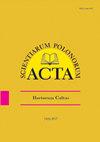接种菌根真菌和生长促进菌并覆盖植物残留物可提高八角茴香(Pimpinella anisum L.)的产量和精油产量
IF 0.7
4区 农林科学
Q4 HORTICULTURE
引用次数: 0
摘要
本实验旨在研究促进生长假单胞菌、菌根真菌和活体地膜对药材茴芹形态和生理性状的影响。该研究是在 2019-2020 农作物年度采用随机完全区组设计的因子设计进行的,安排了三次重复。第一个因素包括四个水平的生物肥料(真菌和细菌)的使用:1)对照(不使用生物肥料);2)菌根真菌;3)生长促进细菌;4)生长促进细菌和真菌的联合使用。第二个因素包括四个层次的覆盖物(植物残留物):1)对照;2)小麦秸秆(3 吨/公顷);3)苜蓿覆盖物(2 吨/公顷);4)在八角行间栽培的活苜蓿覆盖物。三叶草和八角的栽培同时进行。结果表明,结合使用生物肥料(Glomus intraradices 和 Pseudomonas putida)和活体三叶草地膜可显著提高八角的种子产量、收获指数和精油产量。此外,在这种条件下,最高种子产量(930.8 千克/公顷)和最高精油产量(18.15 千克/公顷)分别比对照提高了 48% 和 51%。我们发现,使用活三叶草地膜能显著提高八角的生物产量、种子产量以及伞形花序和小伞形花序的数量。因此,最高生物产量为 5332 公斤/公顷,比对照高出 55%。精油成分的提取结果表明,α-蒎烯和对位伞花蕾烯的含量最高,是精油中的重要成分。此外,α-蒎烯的最大含量(2.277%)是在施用真菌和三叶草的同时进行行间三叶草栽培时观察到的(与对照相比增加了 60%),对位伞花烃的最大值(0.2300%)是在接种细菌和三叶草的同时进行行间三叶草栽培时观察到的(与对照相比增加了 59%)。最后,从药用植物栽培的可持续和有机农业的角度来看,使用生态兼容的投入品,如能稳定食物元素的细菌和真菌,以及使用有生命和无生命的植物覆盖物,可作为提高八角植物数量和质量的一种工具。本文章由计算机程序翻译,如有差异,请以英文原文为准。
Inoculating mycorrhiza fungi and growth-promoting bacteria and mulch of plant residues improve yield and essential oil production of anise (Pimpinella anisum L.)
This experiment aimed to investigate the effects of Pseudomonas growth-promoting bacteria, mycorrhizal fungi, and living mulch on morphological and physiological traits of a medicinal herb, Pimpinella anisum. The study was carried out using a factorial design in a randomized complete block design arrangement with three replications during the crop year of 2019–2020. The first factor includes the use of biological fertilizers (fungi and bacteria) at four levels: 1) control (without the use of biological fertilizers), 2) mycorrhizal fungi, 3) growth-promoting bacteria, 4) combined use of growth-promoting bacteria and fungi. The second factor includes mulch (plant residues) at four levels: 1) control, 2) wheat straw (3 t/ha), 3) berseem clover mulch (2 t/ha), 4) living berseem clover mulch, cultivated among the rows of anise. Cultivation of clover and anise was done simultaneously. Results showed that the combined use of biological fertilizers (Glomus intraradices and Pseudomonas putida) along with living clover mulch led to a significant increase in seed yield, harvest index, and the essential oil yield of anise. Moreover, under such conditions, the highest seed yield (930.8 kg/ha) and the highest essential oil yield (18.15 kg/ha) increased by 48% and 51% compared to the control, respectively. We found that the use of living clover mulch led to a significant increase in biological yield, seed yield, and the number of umbels and umbellets of anise. Accordingly, the highest biological yield of 5332 kg/ha was obtained, which was 55% higher than the control. The extraction of essential oil components showed that α-pinene and para-cymene showed the highest amount and significant components of essential oil. Moreover, the maximum amount of α-pinene (2.277%) observed upon fungi and living clover application along with inter-row clover cultivation (increased by 60% compared to the control), and the maximum value of para-cymene (0.2300%) was obtained upon bacteria and living clover inoculation along with inter-row clover cultivation (increased by 59% compared to the control). Finally, according to the perspectives of sustainable and organic agriculture in medicinal plant cultivation, the use of ecologically compatible inputs such as bacteria and fungi that stabilize food elements, as well as the use of living and non-living plant mulches, can be used as a tool to increase the quantitative and qualitative performance of the anise plant.
求助全文
通过发布文献求助,成功后即可免费获取论文全文。
去求助
来源期刊
CiteScore
1.30
自引率
14.30%
发文量
61
审稿时长
4-8 weeks
期刊介绍:
In Acta Scientiarum Polonorum Hortorum Cultus we publish original research papers and review articles containing new and significant information on broad aspects of horticulture and related disciplines. The papers are published in English only, in six issues yearly.

 求助内容:
求助内容: 应助结果提醒方式:
应助结果提醒方式:


